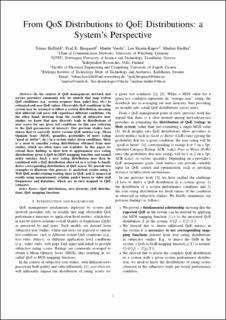| dc.contributor.author | Hossfeld, Tobias | |
| dc.contributor.author | Heegaard, Poul Einar | |
| dc.contributor.author | Skorin-Kapov, Lea | |
| dc.contributor.author | Varela, Martin | |
| dc.date.accessioned | 2020-12-14T10:59:47Z | |
| dc.date.available | 2020-12-14T10:59:47Z | |
| dc.date.created | 2020-12-11T08:30:22Z | |
| dc.date.issued | 2020 | |
| dc.identifier.citation | Quality and User Experience. 2020, 5 (1), . | en_US |
| dc.identifier.issn | 2366-0139 | |
| dc.identifier.uri | https://hdl.handle.net/11250/2719112 | |
| dc.description.abstract | With Quality of Experience (QoE) research having made significant advances over the years, service and network providers aim at user-centric evaluation of the services provided in their system. The question arises how to derive QoE in systems. In the context of subjective user studies conducted to derive relationships between influence factors and QoE, user diversity leads to varying distributions of user rating scores for different test conditions. Such models are commonly exploited by providers to derive various QoE metrics in their system, such as expected QoE, or the percentage of users rating above a certain threshold. The question then becomes how to combine (a) user rating distributions obtained from subjective studies, and (b) system parameter distributions, so as to obtain the actual observed QoE distribution in the system? Moreover, how can various QoE metrics of interest in the system be derived? We prove fundamental relationships for the derivation of QoE in systems, thus providing an important link between the QoE community and the systems community. In our numerical examples, we focus mainly on QoE metrics. We furthermore provide a more generalized view on quantifying the quality of systems by defining a QoE-based Service-level Quality Index. This index exploits the fact that quality can be seen as a proxy measure for utility. Following the assumption that not all user sessions should be weighted equally, we aim to provide a generic framework that can be utilized to quantify the overall utility of a service delivered by a system. | en_US |
| dc.language.iso | eng | en_US |
| dc.publisher | Springer | en_US |
| dc.rights | Navngivelse 4.0 Internasjonal | * |
| dc.rights.uri | http://creativecommons.org/licenses/by/4.0/deed.no | * |
| dc.title | Deriving QoE in Systems: From Fundamental Relationships to a QoE-based Service-level Quality Index | en_US |
| dc.type | Peer reviewed | en_US |
| dc.type | Journal article | en_US |
| dc.description.version | publishedVersion | en_US |
| dc.source.volume | 5 | en_US |
| dc.source.journal | Quality and User Experience | en_US |
| dc.source.issue | 1 | en_US |
| dc.identifier.doi | 10.1007/s41233-020-00035-0 | |
| dc.identifier.cristin | 1858562 | |
| dc.description.localcode | Open AccessThis article is licensed under a Creative Commons Attri-bution 4.0 International License, which permits use, sharing, adapta-tion, distribution and reproduction in any medium or format, as long as you give appropriate credit to the original author(s) and the source, provide a link to the Creative Commons licence, and indicate if changes were made. The images or other third party material in this article are included in the article’s Creative Commons licence, unless indicated otherwise in a credit line to the material. If material is not included in the article’s Creative Commons licence and your intended use is not permitted by statutory regulation or exceeds the permitted use, you will need to obtain permission directly from the copyright holder. To view a copy of this licence, visit http://creat iveco mmons .org/licen ses/by/4.0/. | en_US |
| dc.source.articlenumber | 7 | en_US |
| cristin.ispublished | true | |
| cristin.fulltext | postprint | |
| cristin.fulltext | postprint | |
| cristin.fulltext | postprint | |
| cristin.qualitycode | 1 | |

